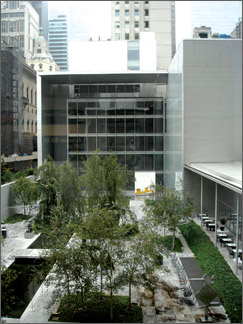Two hours with Giorgio Morandi
Poetry in a white bottle:
Aditha DISSANAYAKE
Two years ago on a day like this in September I was at the
Metropolitan Museum of Modern Art in Manhattan. Nowhere else had my
partner and I been so down and out than in New York that year.
|

Metropolitan Museum of Modern Art in Manhattan |
After waiting in line at the reception desk when we find out the cost
of a ticket for students is $12, (a little over Rs.1200) while a ticket
for visitors cost $20 (Rs.2000), with only $25 dollars between us, he
suggests I go inside on the student ticket and see the much talked about
exhibition of Giorgio Morandi’s paintings, while he sits on the steps
outside.
But, just as he turns to go, a lady standing besides us touches my
hand and asks if we would like to have the extra ticket she has with her
which she had bought for her friend who had failed to turn up.
Amazed at our luck, we thank her profusely before making our way to
the Robert Lehman wing where the paintings are on display.
We make the first, (and thankfully the last) mistake of the day by
walking towards the first picture that catches our eye. The young
officer standing at the entrance walks up to us and suggests we begin
with the paintings near the entrance because everything is in
chronological order. “This would help you trace how Morandi developed as
an artist”, He explains.
We are glad he gives us this valuable piece of advice. This is so
because, when you see two or three of Morandi’s paintings at random,
probably of bottles, vases, over-turned cups and boxes crowding a table
you feel surely you have seen it all.
This, however, is not the way to grasp the essence of his work. With
Morandi it is a case of more is more; you have to see his paintings in
groups, you have to have the chance of tracing a single bottle, a cup or
a vase across his entire painting career.
As you begin to gaze at the pictures, you begin to hear a different
voice calling out to you from each one. The longer the line of paintings
on the walls, the clearer the manipulation of color, the changes in the
light, the difference in space and the shifts in rhythm. The more you
see them the more you realize how remarkable Morandi’s seemingly
unremarkable paintings are.
The reason becomes all too clear, not at once, but gradually,
painting by painting, till you discover inside the tin boxes, bottles,
bowls and the vases, sheer poetry. To see a painting of Morandi,is to
read a few lines from “The Infinite” by his favorite poet, Leopardi.
“It was morning and through the closed shutters, the sun, the first
light of day, crept furtively into my dark room by the balcony.” Morandi
too lets light into his paintings, lavishly at times, sparingly at
others. Walking through the Met show it is easy to imagine the artist
with the studio windows fully open or half closed, as he worked on his
still life paintings.
The shutters would have surely been almost fully closed during his
Metaphysical phase when he used light like a miser. These paintings
drawn during 1918 and 1919, which are the first to draw everybody’s
attention at the show belong to the only period in Morandi’s life when
he attached himself to a “school”.
And, as befits the Metaphysics the objects he painted are supposed to
be seen not as just objects but symbols of the human figure. This burden
of discovering the meaning behind the paintings, drawn with too much
mathematical precision does not seem quite right, not quite the mantra
of Morandi.
What a relief to find the landscapes, the two self portraits and the
still life paintings after the suffocating Metaphysics. Be it in the
pictures of the country side near Bologna, (from 1940) or those of the
city (from 1950), the farmhouses, the fields, the streets, the red-tile
roofs, now bathed in the soft light of spring, now blazing in the heat
of summer, Morandi creates a dream like atmosphere.
It is surprising to realize that the unsentimental symbols of
technology, like the high-tension electric towers in the two landscapes
of Grizzanato painted during World War II, do not obstruct the overall
sense of peace the paintings evoke.
And finally to the truly domestic table cloth, the little vase, the
knife, the cup, all from this world and thankfully with no metaphysical
meanings attached to them. Here is Morandi at his best.
Solemnity and unpretentiousness reign supreme.
By the time I reach the last painting I realize nothing could be more
relaxing than to stare at a bunch of asters and zinnias on top of the
blue and white striped vase; the only object in the picture set against
a background of blue and brown, and find myself totally at peace.
It feels good to know you don’t have to crack your mind trying to
solve what the daubs of paint might represent. A religious idea?
Fascism? Patriotism? If you can stand rooted in front of the single
white bottle with the over turned cup, smiling and telling yourself
“this is beautiful” you would make Morandi happy. This, after all is
what he wanted. Art that evoked emotions solely from what the eye could
see.
At the end of the two hours, I feel I have discovered the allure of
Morandi. With him a “cup is a cup. A tree is a tree”. Here is “Art for
arts sake.” |



